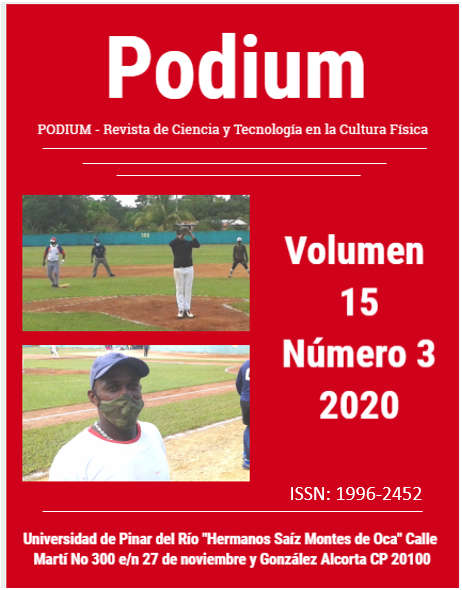Variables del rendimiento de los bateadores del béisbol cubano utilizando el sensor Blast Motion baseball
Contenido principal del artículo
Resumen
La introducción de las nuevas tecnologías en el béisbol ha optimizado los sistemas para el registro y análisis de información, tanto en el entrenamiento como en el juego, contribuyendo a un control más exacto del rendimiento de un jugador. En el presente trabajo, se aplica el sensor Blast Motion baseball cuyo objetivo es identificar las variables significativamente influyentes en el rendimiento de los bateadores en el béisbol cubano. Se eligieron bateadores (N=24) pertenecientes a la Serie Nacional de béisbol LIX debido a que constituye el evento nacional de mayor nivel del béisbol cubano. La información fue registrada en prácticas de bateo, mientras el bateador ejecutaba la tarea de conectar bolas lanzadas por el entrenador de frente (front toss), por encima del brazo a una distancia de 30 pies y a una velocidad inferior a las 50 mph. Posteriormente, se compararon los resultados del Blast Motion Baseball con las estadísticas oficiales de la Serie Nacional de Béisbol LIX. Se demostró que los bateadores con mayor velocidad del bate, mayor velocidad máxima de las manos y mayor potencia lograron un mayor rendimiento ofensivo. Por tanto, conocer en tiempo real estas características del swing contribuyen a perfeccionar el proceso de entrenamiento y predecir el rendimiento deportivo de un bateador.
Descargas
Detalles del artículo
Citas
Adair, R. (2002). The Physics of Baseball. New York: Harper Publishers. Disponible en: http://baseball.physics.illinois.edu/
Breen, J. L. (1967). What makes a good hitter? Journal of Health, Physical Education, Recreation , 38(4), 36-39. Doi: https://doi.org/10.1080/00221473.1967.10610368
Gray, R. (2017). Transfer of training from virtual to real baseball batting. Frontiers in psychology, 8, 2183-2183. Doi: https://doi.org/10.3389/fpsyg.2017.02183
Hernández, R., Fernández, C., & Baptista, P. (2010). Metodología de la Investigación (4 ed.). México: MacGraw-Hill.
Higuchi, T., Nagami, T., Nakata, H., & Kanosue, K. (2018). Head-eye movement of collegiate baseball batters during fastball hitting. PloS one, 13(7), e0200443-e0200443. Doi: https://doi.org/10.1371/journal.pone.0200443
Isaji, K. (2019). The Effect of Warm-Up Sessions with Knob-Loaded, Center-Loaded, and Barrel-Loaded Baseball Bats on Bat Speed in Collegiate Baseball Players. Master of Science, Middle Tennessee State University, Tennessee. Obtenido de: https://jewlscholar.mtsu.edu/handle/mtsu/6072
Liu, S., Edmunds, F. R., Burris, K., & Appelbaum, L. G. (2020). Visual and oculomotor abilities predict professional baseball batting performance. International Journal of Performance Analysis in Sport, 20(4), 683-700. Doi: https://doi.org/10.1080/24748668.2020.1777819
Nakashima, H., Horiuchi, G., & Sakurai, S. ( 2020). Standard of the initial ball velocity for a fly ball in baseball hitting. In Presented at the 13th conference of the International Sports Engineering Association (Vol. 22, p. 25). Presented at the 13th conference of the International Sports Engineering Association, 22, pág. 25. Tokyo. Doi:10.3390/proceedings2020049137
Nathan, A. M. (2003). Characterizing the performance of baseball bats. American Journal of Physics, 71(2), 134-143. Obtenido de: https://aapt.scitation.org/doi/abs/10.1119/1.1522699
Reiter, B. (2018). Astroball: The new way to win it all. . USA: Three Rivers Press.
Szymanski, D. J., Beiser, E. J., Bassett, K. E., Till, M. E., Medlin, G. L., Beam, J. R., & DeRenne, C. (2011). Effect of various warm-up devices on bat velocity of intercollegiate baseball players. The Journal of Strength & Conditioning Research, 25(2), 287-292. Doi:10.1519/JSC.0b013e318202e31e
Szymanski, D. J., DeRenne, C., & Spaniol, F. J. (2009). Contributing factors for increased bat swing velocity. The Journal of Strength & Conditioning Research, 23(4), 1338-1352. Doi:10.1519/JSC.0b013e318194e09c
Szymanski, D. J., Szymanski, J. M., Schade, R. L., Bradford, T. J., McIntyre, J. S., DeRenne, C., & Madsen, N. H. (2010). The relation between anthropometric and physiological variables and bat velocity of high-school baseball players before and after 12 weeks of training. The Journal of Strength & Conditioning Research, 24(11), 2933-2943. Doi:10.1519/JSC.0b013e3181f0a76a
Zou, L., Higuchi, T., Noma, H., Roberto, L. G., & Isaka, T. (2019). Evaluation of a Virtual Reality-based Baseball Batting Training System Using Instantaneous Bat Swing Information. 2019 IEEE Conference on Virtual Reality and 3D User Interfaces (págs. 1289-1290). Osaka: IEEE. Doi:10.1109/VR.2019.8798041


